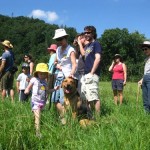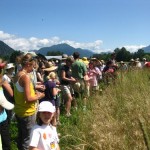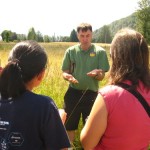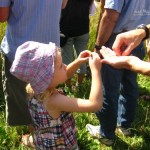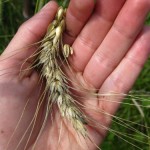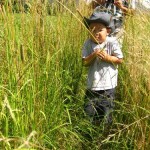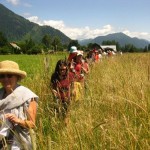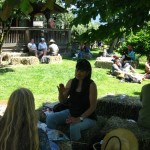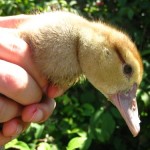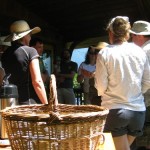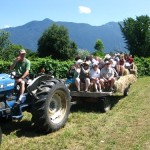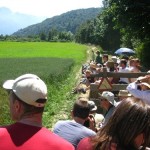
It had been awhile since we last visited Jim in Agassiz, so we dropped by on Monday to chat and see first-hand how the grain was progressing. While it’s always a treat to visit Cedar Isle Farm, we were especially antsy to make it out there this time because 1) our new grain cleaner that we purchased with part of the CSA funds arrived 2) Jim warned us that the winter wheat is showing signs of rust (which had us worried) and 3) the weather has been so darned amazing lately that we knew the farm would look absolutely gorgeous (I think that alone is reason enough.) We have much to share from the trip, so we’re going to spread the visit over a number of posts.
First up, the grain.
Jim approached me awhile back with the possibility of getting the UBC Agriculture faculty to plant some grain test plots on his farm. The idea was to see how well certain varieties grow in Agassiz, since many of the “conventional” grain varieties grown in Canada have been bred for the much drier prairies and BC itself has a great deal of variability among its many micro-climates. We never had time to organize a proper study with the University, but Jim went ahead and planted a few plots himself for comparison.

Among the grains included are Marquis, Soft White Spring and Hard Red Spring (CDC Go). Just starting to make an appearance out of the ground, it’ll be interesting to see how they all fair by the end of the season.

After examining the test plots, the first of the grain that Jim took us out to see was the Triticale.

Compared to the winter wheat planted in the adjacent plot, it grows quite high (around chest height), which makes for a rather picturesque scene as it gently flows in the wind. We were happy to see the crop looking robust and healthy.


By comparison, winter wheat grows much shorter. You can see the stark contrast between it on the left and the Triticale on the right.

If you look closely, you’ll notice a yellowish tinge covering parts of the winter wheat. This is what Jim had warned us about before our visit. Commonly called “rust,” it’s a fungus that thrives in damp environments. winter wheat is particularly vulnerable for that reason because it has to overwinter. Although it shouldn’t prove disastrous, there is a chance that the crop’s yield will be significantly reduced as a result (since winter wheat is supposed to account for half of the CSA crop, this is especially worrying.) Jim said he’s hoping the good weather keeps up for most of the summer so the winter wheat can grow through it. We’ll definitely be watching it closely.


We also checked out the fields at the opposite end of Jim’s farm where the rest of the winter wheat and the more recently planted Hard Red Spring is growing.



All in all, I think the grain is looking pretty great. While the rust issue is certainly a bit disconcerting, it wasn’t nearly as bad as I had initially feared — let’s just keep our fingers crossed for good growing weather throughout the rest of the summer.
(If you’d like to get a better sense of how the grain has progressed, check out our update from last month here.)
Stay tuned for Part 2 when we reveal the fancy new cleaning equipment purchased by the CSA.
 After a cool, wet spring, the wheat is now maturing fast.
After a cool, wet spring, the wheat is now maturing fast.








 2009 CSA members at last year’s farm visit
2009 CSA members at last year’s farm visit
